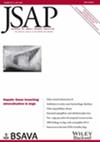Investigation of neutering status and age of neutering in female Dachshunds with thoracolumbar intervertebral disc extrusion
Abstract
Objectives
To evaluate neutering status and age of neutering in female Dachshunds with thoracolumbar intervertebral disc extrusion. We hypothesised that neutered Dachshunds presented with intervertebral disc extrusion at an earlier age, with a higher grade of neurological deficits and with more extensive extrusion of disc material compared with intact females.
Materials and Methods
Retrospective multi-centre study of client-owned female Dachshunds with surgically confirmed thoracolumbar intervertebral disc extrusion. Dogs were classified as early, late or not neutered (intact). Age, body condition score, duration of clinical signs before presentation, modified Frankel score at presentation, length of extruded disc material, maximum spinal cord compression and whether dogs presented for a subsequent intervertebral disc extrusion were recorded.
Results
One hundred and fifty-four dogs were included: 36 early neutered, 69 late neutered and 49 intact. No significant difference was found between early neutered, late neutered and entire female Dachshunds in any of the variables studied.
Clinical Significance
In this cohort of female dogs, neuter status and age of neutering were not found to affect age at onset nor severity of thoracolumbar intervertebral disc extrusion.

 求助内容:
求助内容: 应助结果提醒方式:
应助结果提醒方式:


